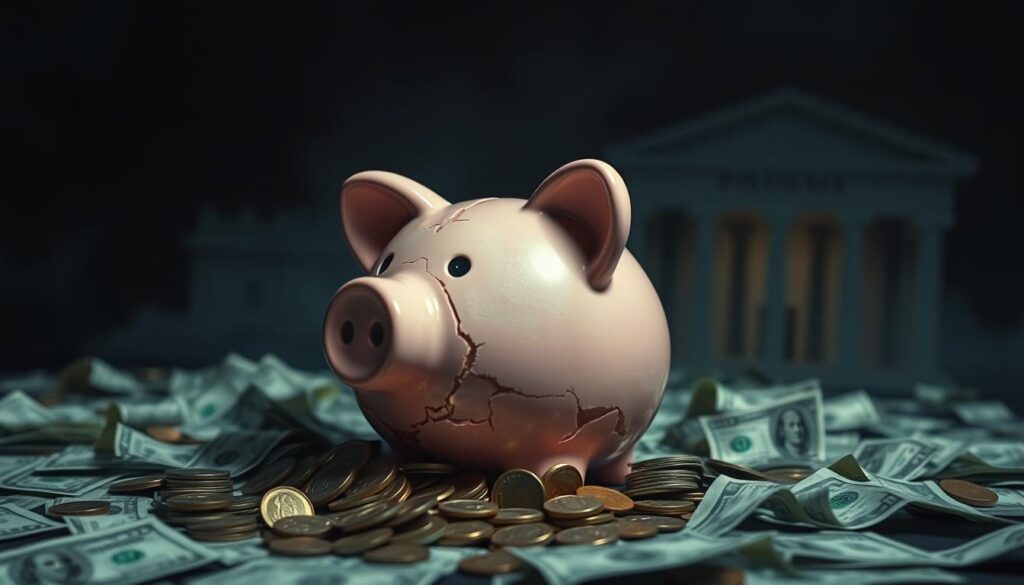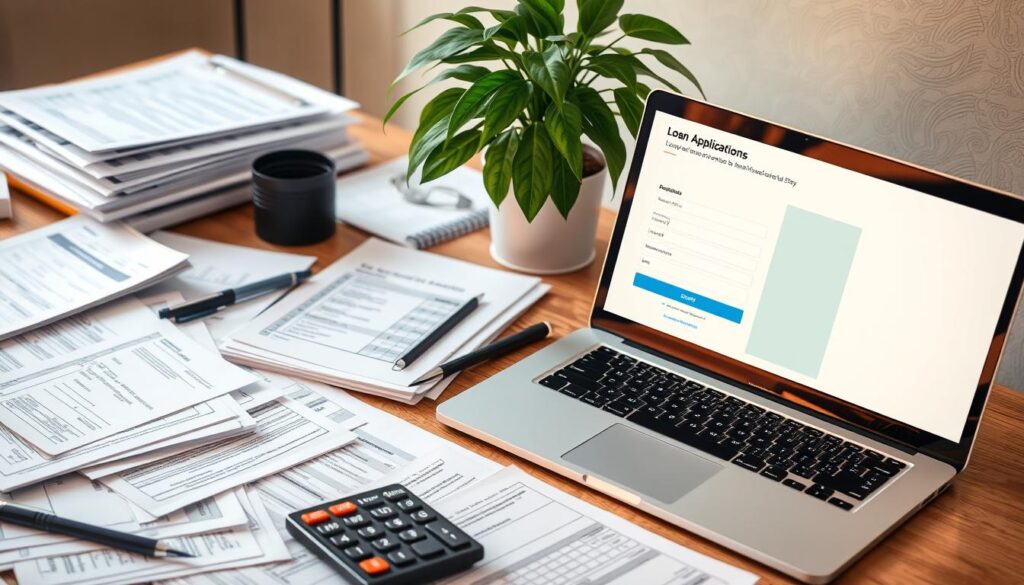Are you having trouble getting a personal loan because of a low credit score? Don’t worry! The world of lending for bad credit is changing, and 2025 might bring new opportunities. But, how can you find your way and boost your loan approval chances?
Table of Contents
Understanding Bad Credit Personal Loans and Their Purpose
People with bad credit often find it hard to get personal loans. Bad credit means scores below 580, showing late payments or debt issues. Yet, bad credit personal loans can help those in need.
What Defines a Bad Credit Score
Credit scores, like FICO or VantageScore, show how likely you are to repay a loan. Scores range from 300 to 850, with higher scores meaning less risk. A score below 580 is considered bad, making it hard to get good loans or credit cards.
Common Reasons for Seeking Bad Credit Loans
- Debt consolidation: Combining debts into one loan can make managing finances easier.
- Emergencies: Unexpected costs, like medical bills or car repairs, need quick money access.
- Credit repair solutions: Bad credit loans can help improve your credit score over time.
Impact of Credit Scores on Loan Terms
Your credit score affects your loan terms. Those with lower scores get higher interest rates and worse terms. This shows lenders see them as riskier. Knowing how credit scores affect loans is key when looking at bad credit personal loans.

Steps to Prepare Before Applying for a Loan
Getting a personal loan with bad credit can seem tough. But, with the right steps, you can boost your chances of getting approved. Before you apply, make sure your finances are in order.
- Review Your Credit Report – Check your credit report for mistakes and fix them fast. Correcting errors can improve your credit score and make you a better candidate for a loan.
- Assess Your Monthly Income and Expenses – Figure out how much you can pay each month towards a loan. This helps you find the right loan amount and terms that fit your budget, ensuring you can pay on time.
- Improve Your Credit Score – Try to increase your credit score by paying off high balances and making all payments on time. A better score can lead to better loan options, like lower interest rates.
- Gather Necessary Documentation – Get ready with proof of income, tax returns, bank statements, and other financial documents. Having these ready can make the loan approval process smoother.
- Research Loan Options – Look into different lenders, like online platforms, credit unions, and banks. Compare interest rates, loan amounts, and repayment terms to find the best option for you.
By taking these steps, you can confidently move through the loan process. Even with bad credit, you can find the financing you need.

Conducting Your Financial Wellness Check
Before you apply for a personal loan, it’s important to check your financial health. Doing a detailed financial wellness check helps you make smart borrowing choices. It also helps you set achievable goals. Let’s look at the main steps in this process.
Analyzing Your Monthly Spending
Begin by looking closely at your monthly spending. Check your bank statements, credit card bills, and any regular payments. This will show you where your money goes. Find ways to cut back on spending, like on things you don’t really need.
This will help you figure out how much you can spend on debt repayment.
Evaluating Your Debt-to-Income Ratio
Next, calculate your debt-to-income ratio. This compares your monthly debt payments to your monthly income. Lenders look at this ratio to judge your creditworthiness.
Try to keep your debt-to-income ratio under 43%. This can help you get a better credit repair solutions or financial planning loan.
Setting Realistic Borrowing Goals
After analyzing your spending and debt ratio, set realistic borrowing goals. Decide on the loan amount you can handle, based on your income, expenses, and payment ability. Remember, borrowing more than you can handle can worsen your financial situation.
If you need help with credit repair solutions or financial planning, talk to a financial advisor or credit counselor. They can offer valuable advice to help you reach your financial goals. They can also guide you in making the best personal loan decisions.
Personal Loans for Bad Credit: Available Options
If you have bad credit, getting a personal loan might seem tough. But, there are many options for those with lower credit scores. These include secured personal loans, unsecured loans, and cosigner loans.
Secured personal loans need collateral, like a car or home, to protect the lender. This might limit your choices but can offer better terms. Unsecured loans don’t need collateral but have higher interest rates and stricter rules.
Another choice is a cosigner loan. A trusted person with good credit signs the loan with you. This can help you get better terms and approval, but the cosigner risks their credit.
Credit unions are also good for those with bad credit. They often lend to members with lower scores. These places might work with you to find a loan that fits your needs.
Peer-to-peer lending sites, like Prosper and LendingClub, match investors with borrowers. They might offer better terms for bad credit. Online lenders like Upgrade, Upstart, and Universal Credit also focus on bad credit loans.
When looking at options, compare interest rates, fees, and repayment terms. This way, you can find the best secured personal loan or cosigner loan for your situation. With the right choice, you can reach your goals.
Types of Secured and Unsecured Lending Solutions
Looking for personal loans with bad credit? You can choose between secured and unsecured loans. Secured loans, like collateral-backed loans, use assets as collateral. This can lead to lower interest rates. Unsecured loans, or signature loans, don’t need collateral but might have higher rates.
Secured Loan Options
Secured loans are a good choice for those with bad credit. Best Egg offers these loans with APRs from 7.99% to 35.99%. Loan amounts range from $2,000 to $50,000.
Oportun provides secured loans with a 10% origination fee. Loans are from $300 to $10,000, with APRs from 32.93% to 35.95%. Navy Federal Credit Union and OneMain Financial also offer secured loans. Their APRs range from 8.99% to 18.00% and 18.00% to 35.99%, respectively.
Unsecured Loan Alternatives
Unsecured signature loans are for those who don’t want to use collateral. Upstart offers these loans with APRs from 7.80% to 35.99%. Loan amounts are from $1,000 to $50,000.
These loans are good for debt consolidation, auto repairs, medical bills, or job loss. But, they might not be as favorable for those with low credit scores.
Comparing Loan Features
When looking at loans, compare APR, repayment terms, loan amounts, and fees. Some lenders offer special features like rate discounts or extended repayment terms. These can help you find the right loan for your financial situation.
How to Compare Bad Credit Lenders Effectively
When looking for a personal loan with bad credit, comparing lenders is key. Look at the minimum credit score needed, the annual percentage rates (APRs), loan amounts, and repayment terms. This helps you find the best loan for your financial situation and needs.
Don’t just look at the loan details. Also, consider how fast the lender funds loans, their customer service, and any extra features. Make sure the lender is real by checking online reviews, state licenses, and if they have a physical address. Use personal loan calculators to figure out monthly payments and total costs, helping you make a smart choice.
Try pre-qualifying with several lenders. This lets you compare offers without hurting your credit score, as it’s a soft check. By comparing different lenders, you can choose the best personal loan that meets your lender comparison and loan qualification criteria.
- Evaluate minimum credit score requirements
- Compare APR ranges and loan amounts
- Review repayment terms and funding speed
- Assess customer service and additional features
- Verify lender legitimacy through reviews and licenses
- Use loan calculators to estimate monthly payments
- Pre-qualify with multiple lenders to compare offers
Understanding APR and Interest Rates
When you get a personal loan, knowing about annual percentage rates (APR) and interest rates is key. The APR shows the interest rate and any extra fees, giving you a full picture of the loan’s cost. This is vital when you’re looking at different loan options.
Fixed vs. Variable Rates
Personal loans can have fixed or variable interest rates. Fixed rates stay the same for the whole loan term, helping you plan better. Variable rates can change over time, making planning harder but sometimes starting with a lower rate.
Additional Fees and Charges
There are also extra fees and charges with personal loans. These include origination fees, late payment fees, and prepayment penalties. Knowing all these costs is important to find the best loan for your budget.
Experts say the highest APR for a good personal loan should be 36% or less. By looking at APR, interest rates, and fees, you can pick a loan that fits your financial plans and budget.
The Role of Credit Unions in Bad Credit Lending
Credit unions can help when you need a personal loan with bad credit. They are member-owned financial institutions. This means they might be more flexible and willing to work with you, even if your credit score is low.
Compared to banks, credit unions often offer lower interest rates. They also provide more personalized service. This is because they focus on your unique financial situation.
Many credit unions offer tools and programs to help improve your credit. They provide financial counseling and education. This helps member-owners make better financial choices and reach their goals.
If you’re having trouble getting a loan because of bad credit, think about joining a credit union. They focus on your overall financial health, not just your credit score. This could lead to loan approval and help you rebuild your credit.
Online Lenders vs. Traditional Banks
The world of personal loans is changing fast. Fintech companies and online lenders are making it easier to get loans, even with bad credit. They offer quick digital applications and fast approval.
Advantages of Digital Lending
Online lenders make borrowing easier and faster than traditional banks. They use more than just credit scores to decide. This helps people with poor credit.
The online application is quick. You can get your loan fast, sometimes the same day or the next business day.
Security Considerations
It’s important to check the security of online lenders. Make sure their website is secure and they protect your personal info. Banks may offer more support but have stricter rules for bad credit.
Choosing between online lenders and banks depends on your needs. Online lenders are quick and flexible. Banks offer personal service and lower rates for good borrowers.
Improving Your Chances of Loan Approval
Getting a personal loan with bad credit is tough. But, there are ways to boost your approval chances. Adding a cosigner with good credit to your application is a smart move. It shows lenders you have a reliable backer.
Another strategy is to offer collateral for a secured loan. This means using something valuable, like a car or home equity, as security. Secured loans often have better rates and terms because they’re less risky for lenders.
- Think about asking for a smaller loan. Lenders might say yes to a smaller amount, especially if your credit isn’t great.
- Try to improve your credit score. Pay bills on time, fix any credit report errors, and lower your credit use.
- Show lenders you have a steady income and job. This proves you can make loan payments on time.
It’s also key to prepare a detailed and accurate loan application. Collect all needed documents, like income and bank statements, and make sure your info is correct. By doing these things, you can greatly increase your chances of getting the loan you need, even with bad credit.
The Application Process Step by Step
Getting a personal loan, especially with bad credit, needs careful planning. You’ll need to give personal and financial details. You’ll also have to agree to a credit check and provide extra documents if needed.
Required Documentation
Here’s what you usually need for a bad credit personal loan:
- Proof of income, such as pay stubs, bank statements, or tax returns
- A government-issued ID, like a driver’s license or passport
- Bank statements to show your financial history
- Tax returns, if you’re self-employed or need a bigger loan
Timeline Expectations
The time it takes to process your loan varies by lender. Online lenders can be quicker, sometimes offering instant approval. Banks and credit unions might take a few days for loan underwriting and application processing.
Once approved, you could get your money in one business day. This depends on the lender.
Being ready with the right documents and a complete application helps. It makes the approval process smoother and faster. Knowing what’s needed increases your chances of getting a loan, even with bad credit.
Alternative Options When Loans Aren’t Approved
If your loan application is denied, don’t give up. There are other ways to get the money you need. You could try for a secured credit card to improve your credit score. Also, look into credit counseling services or debt management plans to fix your finances.
Check out local groups or charities for financial help. If all else fails, you might borrow from friends or family. But make sure to set clear payment plans. The main goal is to boost your credit score by managing your money wisely.
Exploring these options can help you get the funds you need and build a stronger financial base. Stay hopeful and keep striving for your goals. With the right approach, you can beat poor credit and reach your financial dreams.


